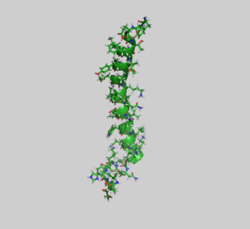Glucose-dependent insulinotropic peptide
| Glucose-dependent insulinotropic peptide | ||
|---|---|---|

|
||
| according to PDB 2OBU | ||
|
Existing structural data: 1t5q, 2obu, 2b4n |
||
| Properties of human protein | ||
| Mass / length primary structure | 42 aa; 4.98 kDa | |
| Precursor | (132 aa; 14.9 kDa) | |
| Identifier | ||
| Gene name | GIP | |
| External IDs | ||
| Occurrence | ||
| Parent taxon | Higher mammals | |
| Orthologue | ||
| human | mouse | |
| Entrez | 2695 | 14607 |
| Ensemble | ENSG00000159224 | ENSMUSG00000014351 |
| UniProt | P09681 | Q9D887 |
| Refseq (mRNA) | NM_004123 | NM_008119 |
| Refseq (protein) | NP_004114 | NP_032145 |
| Gene locus | Chr 17: 44.39 - 44.4 Mb | Chr 11: 95.89 - 95.89 Mb |
| PubMed search | 2695 |
14607
|
The glucose-dependent insulinotropic peptide ( GIP ), formerly of the same acronym as Gastroinhibitorisches peptide or Gastrointestinal inhibitory peptide designated, consists of 42 amino acids and is in the K-cells of the duodenum ( the duodenum ) formed peptide hormone .
In the past, the neutralization of gastric acid (see pH value ) and the slowing down of gastric emptying were seen as the main effects. These effects are only observed at unphysiologically high GIP concentrations, but they are usually controlled by another hormone, namely secretin .
Today, a stimulation is the main effect of insulin in B-cells of the pancreas ( pancreatic shown) for food intake. Inhibiting the effect of GIP reduces the development of obesity and insulin resistance on a high-fat diet. It is believed that GIP plays a crucial role in the switch from fat oxidation to fat storage when the insulin effect declines. It could play an important role in the secondary prevention of insulin resistance.
literature
- Zhou H et al .: Gastric inhibitory polypeptide modulates adiposity and fat oxidation under diminished insulin action. Biochem Biophys Res Commun (2005) 335 (3): 937-42. PMID 16105663